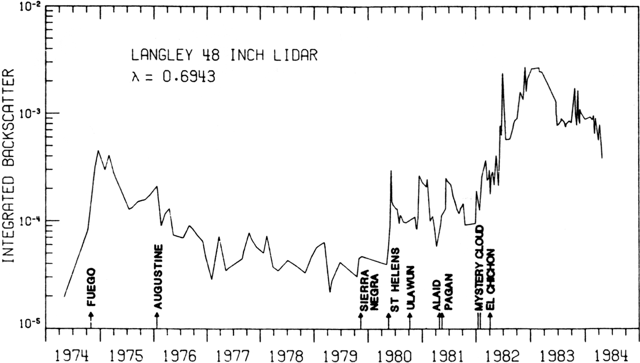Report on Atmospheric Effects (1980-1989) — August 1984

Atmospheric Effects (1980-1989)
Scientific Event Alert Network Bulletin, vol. 9, no. 8 (August 1984)
Managing Editor: Lindsay McClelland.
Atmospheric Effects (1980-1989) 10 years of lidar data from Virginia summarized
Please cite this report as:
Global Volcanism Program, 1984. Report on Atmospheric Effects (1980-1989) (McClelland, L., ed.). Scientific Event Alert Network Bulletin, 9:8. Smithsonian Institution.
Atmospheric Effects (1980-1989)
All times are local (unless otherwise noted)
H. H. Lamb's report describes observations from Holt, England (52.9°N, 1.1°E), about 30 km N of Norwich, his previous observing site.
"Twilight optical effects presumably attributable to the remnants of the El Chichón aerosol remained visible on clear evenings in November, 1983, but then became less noticeable and in early 1984 seemed generally weak. After a long period in which an untrained observer would surely have noticed nothing unusual about the twilight glows, on 19 August pink crepuscular rays reached 20-22° elevation at 1945-1950 GMT, about a half-hour after sunset, indicating an illuminating layer at about 25-27 km altitude."
Little variation was seen in aerosol profiles measured by lidar at Mauna Loa, Hawaii in August and at Hampton, Virginia in August and early September. Integrated backscattering at Mauna Loa was consistently higher in August than in July; values dropped somewhat at Hampton. The lidar profile at Mauna Loa suggested that aerosols extended downward several km into the troposphere from the stratospheric layer. Figure 7 shows changes in stratospheric aerosols over Hampton during the past 10 years, with timing of large explosive eruptions.
 |
Figure 7. Atmospheric effects of some large explosive eruptions, 1974-1984. Integrated backscattering measured at the 48-inch lidar at Hampton, Virginia. Courtesy of the NASA Langley Research Center. |
Information Contacts: H. Lamb, Univ. of East Anglia, England; W. Fuller, NASA; T. DeFoor, MLO.
